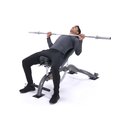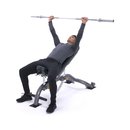Do you know the difference between a "beginner version" and an "advanced version" of a bench-press workout? The most obvious, of course, is that an advanced trainer uses a lot more weight and does more sets. But if you look deeper, there's one thing experienced lifters usually do that sets them apart from your average bencher.
Here's the difference: Most of us tend to favor techniques that make an exercise easier—like bouncing the bar off our chest, lifting our butt off the bench, or shortening the range of motion. But veteran lifters find ways to make a movement more challenging.
That's where I come in. You know the four chest exercises in this routine, but each one has been improved with the addition of a technique to make it harder.
You can love me or hate me for what you are about to read. Either way, your chest will grow.

BodyFit
$6.99/month- 2,500+ expert-created single workouts
- 3,500+ how-to exercise videos
- Detailed workout instruction
- Step-by-step workout tips
- Training at gym or at home
- Access to Workout Plans
- Access to Bodyfit App
- Store Discounts
Already have a Bodybuilding.com account with BodyFit? Sign In

What comes with BodyFit?

- Instructional Videos
Don't risk doing a workout improperly! Avoid injury and keep your form in check with in-depth instructional videos.

- How-to Images
View our enormous library of workout photos and see exactly how each exercise should be done before you give it a shot.

- Step-by-Step Instructions
Quickly read through our step-by-step directions to ensure you're doing each workout correctly the first time, every time.
1. Incline Press + Rest-Pause 16s
If you always do flat bench presses first before inclines, your mid-chest region will likely grow faster and better than the upper pecs. If that sounds like you, it's time to flip the order of your training. Do incline benches first, and hit them hard so you can start correcting this imbalance. Of course, if your upper chest is already top shelf, you could gear the first two lifts of this workout to flat or decline benches.
In a perfect world, your incline-bench station will have an angle of 15-30 degrees. Many of them approach 45 degrees, but that should be the absolute steepest you go. Otherwise, you end up doing more of a shoulder exercise.
Doing It Right: While this exercise itself isn't unique, the intensity technique you'll be using is. I call my approach "16s."
Load your 8RM—a weight you can do for just 8 reps—on the bar. With a spotter on hand, do 8 reps, then rack the barbell. After just a 15-second rest, unrack it and do 2 more reps. You'll repeat this 2-rep/15-second-rest pattern for four segments in all: 8+2+2+2+2=16 reps. That's double the number of reps you'd normally get with your 8RM.
Doing 16s is a type of density training—doing more work in less time—that builds size and strength. If you can do more than 2 reps on your last set, just go to failure. Do 2 sets of incline 16s for what amounts to 10 mini sets. You'll be tired coming out of the first round, so reduce the load on your second set by 10-15 percent.
Bonus Tip: Never do this with dumbbells. They're harder to control, especially when you're training near failure on so many mini sets. It's also hard to get them into and out of the start position so many times. If you train alone, use the Hammer-Strength incline press or Smith machine with the safeties set at the low end of the ROM.
2. Smith Machine Incline Press With Pauses
Now that you've blasted your upper chest with some extreme intensity, you're going to put another nail in the coffin by dialing up the time under tension and overloading both the eccentric and concentric portions of the movement. Be forewarned: It's tough!
If you focus only on the positive contractions, you're leaving growth opportunities on the table. You can handle a much greater load lowering a weight (eccentric) than lifting it (concentric), right? You can also produce more force isometrically (a static contraction in which there's no movement) than you can concentrically. So let's put both these heavyweight contractions together while increasing time under tension. It hurts just thinking about what this will feel like, but it will pay off with strength and size gains!
Doing It Right: Do this exercise on a Smith machine. You'll do all repetitions with a full range of motion for 3 working sets of 6. But these shouldn't be vanilla reps: As you lower the weight from full extension, stop a quarter of the way down and pause for 3 seconds. Stop again three-quarters of the way down and pause for another 3 seconds. Keep tension on your pecs as the bar approaches your chest. Then finish the assault by pushing the bar back up as forcefully as you can.
The overload is hellacious. Over the 6 repetitions, you'll pause for a total of 36 seconds. Focus on maintaining control throughout the exercise so you can hit all the stopping points.
So there it is. In one set, you've overloaded all three types of contractions. If this isn't a recipe for hypertrophy, I don't know what is.
Bonus Tip: If you're an athlete training for a sport that requires pushing, try this same movement, but pause at the same spots on the concentric rep.
3. Standing Fly With Resistance Band
Just about everyone agrees on the effectiveness of the single-joint dumbbell fly. Unfortunately, all too many lifters can't do them because of shoulder and/or pec injuries.
If you're in that situation, the standing band fly can help you work around your vulnerabilities at the fully open portion of a dumbbell fly. It works so well because the band exerts the least resistance at the point where injury might have made you the weakest, and then provides the most resistance where you're strongest. So the exercise protects your shoulder and/or pecs more at the beginning, and overloads the movement's entire strength curve while providing continuous tension from the band.
Now for that extra challenge: Instead of doing the fly for a predetermined rep count, you'll do it for time: 3 sets of 60 seconds. Get ready for the biggest pec pump of your life!
Do It Right: Like a traditional dumbbell fly, do this movement as if you're giving somebody a giant bear hug. Lock a 15-degree bend in your elbows for the duration of the movement. Focus on making your chest muscles do all the work, and use a band that fits your strength.
Bonus Tip: Step back closer to the point where the band is anchored to decrease resistance; step away to increase it.
4. Juarez Valley Method Dips
For well over half a century, since the days of bodybuilding pioneers Vince Gironda and Marvin Eder, dips have become a staple of chest size and strength routines. You'll be doing these dips in a different way, using the Juarez Valley Method from my article The Jailhouse Strong Routine.
Never heard of the Juarez Valley Method? This method isn't from some celebrity gym: It's straight out of Cereso Prison in Juarez, Mexico. So expect it to be simple but brutal.
Do It Right: According to the masterminds behind the Juarez Valley Method, you do reps in descending order on all odd-numbered sets, and ascending order on even-numbered sets. So you do 10 reps, then 1 rep; 9 reps, then 2 reps; 8 reps, then 3 reps; and so on until you meet in the middle at 5 sets. A "Juarez Valley 10" looks like this:
- Set 1: 10 Reps
- Set 2: 1 Reps
- Set 3: 9 Reps
- Set 4: 2 Reps
- Set 5: 8 Reps
- Set 6: 3 Reps
- Set 7: 7 Reps
- Set 8: 4 Reps
- Set 9: 6 Reps
- Set 10: 5 Reps
Between each set, walk 8 feet away and 8 feet back—the length of a prison cell—for a bit of recovery. Don't add weight to these over time; the goal is to improve exercise density by getting the sets done faster and faster.
I don't recommend going any lower than where your upper arms are parallel to the floor for these dips. Also, lean forward as you dip to put more emphasis on the chest and less on the triceps. And since you're at the end of your workout, don't add any additional weight—no matter what strength level you're at. Your body weight is more than enough here.
Bonus Tip: If you're unable to do dips for any reason, do push-ups instead. If you can't do at least 10 dips, use an assisted-dip machine.




